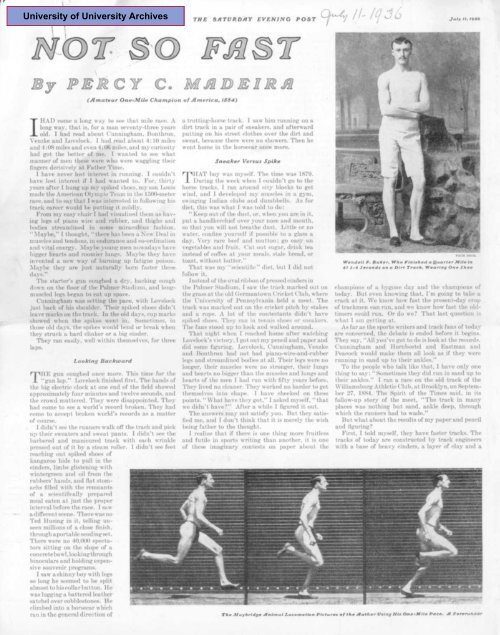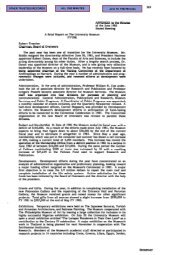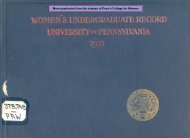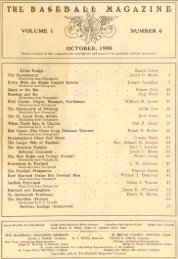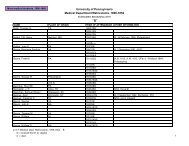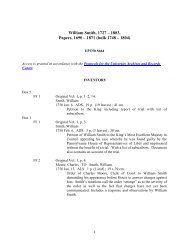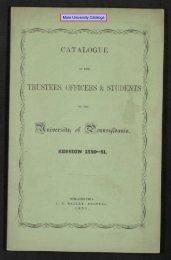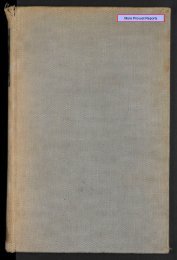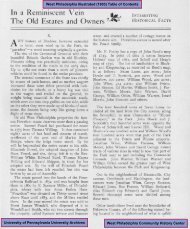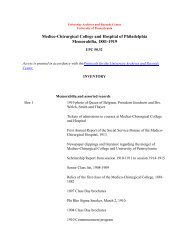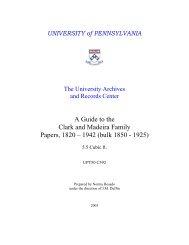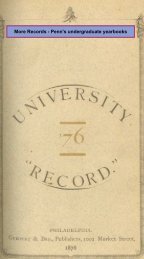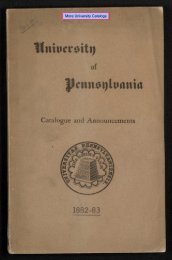Percy C. Madeira - University Archives and Records Center ...
Percy C. Madeira - University Archives and Records Center ...
Percy C. Madeira - University Archives and Records Center ...
You also want an ePaper? Increase the reach of your titles
YUMPU automatically turns print PDFs into web optimized ePapers that Google loves.
16<br />
Not So Fast<br />
THE SATURDAY EVENING POST<br />
PERCY C . MADEIR A<br />
(Amateur One-Mile Champion of America, 1884)<br />
I had come a long way to see that mile race . A<br />
long way . that is, for a man seventy-three years<br />
old . I had read about Cunningham, Bonthron ,<br />
Venzke <strong>and</strong> Lovelock . I had read about 4 :1 0 miles<br />
<strong>and</strong> 4:O8 miles <strong>and</strong> even 4 :06 miles, <strong>and</strong> my curiosit y<br />
had got the better of me . I wanted to see wha t<br />
manner of men these were who were waggling thei r<br />
fingers derisively at Father Time .<br />
I have never lost interest in running . I could n ' t<br />
have lost interest if I had wanted to . For, thirt y<br />
years after I hung up my spiked shoes, my son Loui s<br />
made the American Olympic Team in th e 1500-meter<br />
race . <strong>and</strong> to say that I was interested in following hi s<br />
track care e r would be putting it mildly .<br />
From my easy chair I had visualized them a<br />
ing legs of piano wir e <strong>and</strong> rubber. <strong>and</strong> thighs s hav an d<br />
bodies streamlined in some miraculous fashion .<br />
"Maybe." I thought, "there has been a New Deal i n<br />
muscles <strong>and</strong> tendons, in endurance <strong>and</strong> coordination<br />
<strong>and</strong> vital energy . Maybe young men nowadays hav e<br />
bigger hearts <strong>and</strong> roomier lungs . Maybe they hav e<br />
invented a new way of burning up fatigue poison .<br />
Maybe they are just naturally born faster thes e<br />
days ."<br />
The starter 's gun coughed a dry, hacking cough<br />
down on the floor of the Palmer Stadium, an<br />
.<br />
d long-muscled legs began to eat up space<br />
Cunningham was setting the pace, wit h Lovelock<br />
just back of his shoulder . Their spiked shoes didn ' t<br />
leave marks on the track . In the old days, cup mark s<br />
showed when the spikes went in . Sometimes . i n<br />
those old days . the spikes would bend or break whe n<br />
they struck a hard clinker or a big cinder.<br />
They ran easily, well within themselves, for three<br />
laps .<br />
Looking Backward<br />
T HE gun coughed once more . This time for th e<br />
"gun lap ." Lovelock finished first . The h<strong>and</strong>s o f<br />
the big electric clock at one end of the field showe d<br />
approximately four minutes <strong>and</strong> twelve seconds . an d<br />
the crowd muttered . They were disappointed . They<br />
had come to see a world 's record broken . They ha d<br />
come to accept broken world ' s r ecords as a matter<br />
of course .<br />
I didn't see the runners walk off the track <strong>and</strong> Pic k<br />
up their sweaters <strong>and</strong> sweat pants . I didn't see th e<br />
barbered <strong>and</strong> manicured track with each wrinkl e<br />
pressed out of it by a steam roller. I didn't see feet<br />
reaching out spiked shoes of<br />
kangaroo hide to pull in th e<br />
cinders, limbs glistening wit h<br />
wintergreen <strong>and</strong> oil from th e<br />
rubbers' h<strong>and</strong>s, <strong>and</strong> flat stom -<br />
achs filled with the remnant s<br />
of a scientifically prepared<br />
meal eaten at just the prope r<br />
interval before the race . I sa w<br />
a different scene. There was no<br />
Ted Husing in it . telling unseen<br />
millions of a close finish ,<br />
through a portable sending set .<br />
There were no 40,000 spectators<br />
sitting on the slope of a<br />
concrete bowl, looking through<br />
binoculars <strong>and</strong> holding expensive<br />
souvenir programs .<br />
I saw a skinny boy with leg s<br />
so long he seemed to be spli t<br />
almost to his collar button .<br />
was lugging a battered leathe r<br />
satchel over cobblestones . H e<br />
climbed into a horsecar which<br />
ran in the general direction of<br />
a trotting-horse truck . I saw him running on a<br />
dirt track in a pair of sneakers, <strong>and</strong> afterwar d<br />
putting on his street clothes over the dirt an d<br />
sweat, because there were no showers . Then h e<br />
went home in the horsecar once more .<br />
Sneaker Versus Spik e<br />
THAT boy was myself . The time was 1879.<br />
During the week when I couldn't go to th e<br />
horse tracks . I ran around city blocks to ge t<br />
wind, <strong>and</strong> I developed my muscles in a gym ,<br />
swinging Indian clubs <strong>and</strong> dumbbells . As fo r<br />
diet, this was what I was told to do :<br />
" Keep out of the dust, or. when you are in i t,<br />
put a h<strong>and</strong>kerchief over your nose <strong>and</strong> mouth .<br />
so that you will not breathe dust . Little or n o<br />
water . confine yourself if possible to a glas s a<br />
day . Very rare beef <strong>and</strong> mutton ; go easy o n<br />
vegetables <strong>and</strong> fruit . Cut out sugar, drink tea<br />
instead of coffee at your meals, stale bread, o r<br />
toast, without butter ."<br />
That was my "scientific" diet, but I did no t<br />
follow it .<br />
Instead of the oval ribbon of pressed cinders i n<br />
the Palmer Stadium, I saw the track marked out o n<br />
the grass at the old Germantown Cricket Club, wher e<br />
the <strong>University</strong> of Pennsylvania held a meet . Th e<br />
track was marked out on the cricket pitch by stakes<br />
<strong>and</strong> a rope . A lot of the contestants didn 't hav e<br />
spiked shoes . They ran in tennis shoes or sneakers .<br />
The fans stood up to look <strong>and</strong> walked around .<br />
That night when I reached home after watchin g<br />
Lovelock's victory, I got out my pencil <strong>and</strong> paper an d<br />
did some figuring. Lovelock, Cunningham . Venzk e<br />
<strong>and</strong> Bonthro n had not had piano-wire-<strong>and</strong>-rubbe r<br />
legs <strong>and</strong> streamlined bodies at all . Their legs were n o<br />
longer, their muscles wer e no stronger, their lungs<br />
<strong>and</strong> hearts no bigger than the muscles <strong>and</strong> lungs an d<br />
hearts of the men I had run with fifty years before .<br />
They lived no cleaner. They worked no harder to ge t<br />
themselves into shape . I have checked on these<br />
points. "What have they got ," I asked myself, "tha t<br />
we didn 't have? " After a while I figured it out .<br />
The answers may not satisfy you . But they satisfied<br />
me, <strong>and</strong> I don't think that it is merely the wis h<br />
being father to the thought .<br />
I realize that if there is one thing more fruitles s<br />
<strong>and</strong> futile in sports writing than another, it is on e<br />
of these imaginary contests on paper about the<br />
He<br />
July 11 .193 6<br />
Wendell F . Raker, Who Finished a Quarter Mile i n<br />
47 3/4 Seconds on a Dirt Track, Wearing On e Shoe<br />
champions of a bygone day <strong>and</strong> the champions o f<br />
t oday . But even knowing that . I'm going to take a<br />
crack at it . We know how fast the present-day cro p<br />
of trackmen can run, <strong>and</strong> we know how fast the old -<br />
timers could run . or do we? That last question i s<br />
what I am getting at .<br />
As far us the sports writers <strong>and</strong> track fans of toda y<br />
are concerned, the debate is ended before it begins .<br />
They say . "All you ' ve got to do is look at the records .<br />
Cunningham <strong>and</strong> Hornbostel <strong>and</strong> Eastman an d<br />
Peacock would make them all look as if they wer e<br />
running in s<strong>and</strong> up to their ankles . "<br />
To the people who talk like that, I have only on e<br />
thing to say : "Sometimes they did run in s<strong>and</strong> up t o<br />
their ankles ." I ran a race on the old track of th e<br />
Williamsburg Athletic Club, at Brooklyn, on September<br />
27, 1884. The Spirit of the Times said, in it s<br />
follow-up story of the meet, "The track in many<br />
places was nothing but s<strong>and</strong>, ankle deep, throug h<br />
which the runners had to wade ."<br />
But what about the results of my paper <strong>and</strong> penci l<br />
<strong>and</strong> figuring ?<br />
First, I told myself, they have faster tracks . Th e<br />
tracks of today are constructed by track engineer s<br />
with a base of heavy cinders, a layer of clay <strong>and</strong> a<br />
The Muybridge Animal Locomotion Pictures of the Author Using His One Mile Pace. A Forerunner<br />
.
Lon Myers . Who HeId Enough <strong>Records</strong> for Three<br />
Men . Ranging, All the Way From 100 Yards to One Mil e<br />
layer of fine cinders on top . They are planned fo r<br />
resilience <strong>and</strong> spring . They are planned to drai n<br />
easily . They are swept <strong>and</strong> rolled before big races .<br />
They are cared for constantly, every day, until the y<br />
are like billiard tables .<br />
According to Mr . William J. Bingham, Director of<br />
Athletics at Harvard <strong>University</strong> . it has been estimated<br />
that the present stadium track is about si x<br />
seconds faster than the first Harvard stadium track ,<br />
the one built in I897 .<br />
Lawson Robertson, the Olympic coach, who know s<br />
more about track athletics than any other man I<br />
know, is of the opinion that the track in the Olympi c<br />
Stadium at Los Angeles, which has a base of peat, is<br />
some seconds faster than the Harvard track .<br />
It was on a fifth-of-a-mile track, with two mor e<br />
turns to the mile than the modern quarter-mil e<br />
track, that the early Intercollegiate Association an d<br />
the National Association held their meets .<br />
Second, today we have tenth-of-a-second sto p<br />
watches. Fifty years ago, the stop watches cut the<br />
seconds into quarters, later into fifths, <strong>and</strong> now int o<br />
tenths. If a man ran a hundred yards in nine an d<br />
eight-tenths seconds fifty years ago, his time would<br />
be recorded as ten seconds . In order to get a better<br />
THE SATURDAY EVENING POS T<br />
record, he would have had to run fast enoug h<br />
to register nine <strong>and</strong> three-fourths . <strong>and</strong> h e might<br />
have had to run it in nine <strong>and</strong> six-tenths t o<br />
have cut his official time down to nine an d<br />
three-fourths seconds .<br />
I asked Lawson Robertson what advantage<br />
it would be fair to say the tenth-second sto p<br />
watch gives the present-day runner, <strong>and</strong> h e<br />
said, "The advantage would be about twotenths<br />
of a second . "<br />
Third, the modern crouching start . All race s<br />
used to start with a st<strong>and</strong>ing start when I wa s<br />
running . Mike Murphy . who developed th e<br />
crouch start. used to say it was worth a tent h<br />
of a second to a runner . Robertson thinks it i s<br />
worth more than a tenth of a second .<br />
Fourth . the 220 used to be run around a curve ,<br />
<strong>and</strong> the start was at the beginning of the curve .<br />
The lanes were not staggered : in fact, there<br />
were no lanes . The result was a crowding of th e<br />
contestants, a jostling <strong>and</strong> pushing <strong>and</strong> elbowing,<br />
<strong>and</strong> an inability r eally to get under way<br />
until the straightaway was reached . A man on<br />
the outside sometimes had to run yards farther<br />
than a man on the pole . I asked Robertson to<br />
figure the time advantage the modern 220<br />
straightaway gave a runner .<br />
"One full second ." he said .<br />
I asked him . " What about the elimination of<br />
one curve from the quarter mile? We used t o<br />
run it around two curves . By the time the runners<br />
have hit the first curve now, they ar e<br />
straightened out, <strong>and</strong> all scrambling <strong>and</strong> jockey -<br />
ing has been eliminated . "<br />
Robertson thinks that a man running a quarter<br />
around one curve instead of two has a time<br />
advantage of eight-tenths of a second before he<br />
even steps on the track .<br />
In addition to these things . I thought of others .<br />
no less important to my mind . As a matter of fact .<br />
perhaps more important than improved tracks ,<br />
crouching starts <strong>and</strong> tenth-secon d<br />
watches .<br />
First, expert coaching . Serond, com -<br />
competition . Third, a new mental ceiling .<br />
Educating Feet<br />
HE clubs, colleges, universities,<br />
Thigh schools <strong>and</strong> prep schools of<br />
today employ men whose business i t<br />
is to polish <strong>and</strong> perfect the form of th e<br />
young men under them . They kno w<br />
about rhythm, timing, co-ordinatio n<br />
<strong>and</strong> obtaining a maximum r esul t<br />
from the minimum effort . They mak e<br />
sure that their teams will go into<br />
competition knowing all that the<br />
champions know, by the use of slo w<br />
movies, charts, diagrams <strong>and</strong> measurements<br />
.<br />
Their stars begin where th e<br />
champions of last year. <strong>and</strong> the year<br />
of the Motion Picture . Above— William Byrd Page Who jumped Nine Inches Higher Than His Own Head . to a World's Record<br />
1 7<br />
before, left off. as far as a knowledge of technique i s<br />
concerned .<br />
In my day . we taught ourselves . Or we comp e ted<br />
untaught . We sailed over hurdles instead of clipping<br />
them scissorwise, because we didn't know any bet -<br />
ter. We flung ourselves at a broad jump take-off o r<br />
at the high jump <strong>and</strong> vaulting crossbars with a will .<br />
but without the placing of colored pegs at certai n<br />
mathematically spaced intervals along the runway .<br />
worked out to a fraction of an inch by a coach . W e<br />
didn ' t know about moving the vaulting st<strong>and</strong>ards<br />
back from the pit when the bar climbed higher, so<br />
that our trajectory would lift : we hit the jumping<br />
take-offs helter-skelter, either inches behind or foul -<br />
ing, instead of so judging our run that every last inc h<br />
would he utilized .<br />
Stepchildren of the Cinders<br />
UR old ash vaulting poles had no spring . The y<br />
O were of heavy wood which was clumsy to manipulate<br />
. <strong>and</strong> there was no box sunk into the ground into<br />
which to thrust your pole while vaulting, as is th e<br />
case now . We didn 't know that a pole of bamboo<br />
would act as a catapult <strong>and</strong> throw a man inche s<br />
higher in the air . We thought we were lucky if the<br />
ash pole didn't break in midair <strong>and</strong> impale a vaulte r<br />
on its jagged halves .<br />
We had no trainers who made us check our weight s<br />
on a chart before <strong>and</strong> after each practice, to see<br />
whether or not we were drawing our edge too fine .<br />
Nobody told us what to do each day in order to approach<br />
a race at the peak of condition. No coach o r<br />
manager took care of all the petty <strong>and</strong> annoying little<br />
details of buying tickets, arranging hotel accommodations<br />
. transportation to <strong>and</strong> from the meet . an d<br />
of seeing that our baggage was in the dressing roo m<br />
for us when we got there. No manager kept an ey e<br />
on the progress of the meet <strong>and</strong> saw to it that we we r e<br />
warmed up in time <strong>and</strong> out on the track to r eport t o<br />
the clerk of the course . (Continued on Pa te 7 7
And we paid our own expenses .<br />
Competition today is sharply different<br />
from the competition of my day .<br />
The number of contestants in one o f<br />
our national championships of today<br />
would be about equal to the number<br />
of spectators in an average meet of<br />
fifty years ago . The number of athletes<br />
who competed in a fixture like the<br />
Penn Relays last year was greate r<br />
than all the track athletes in the worl d<br />
when I first ran in a race . Th e modern<br />
Olympic Games were years away . The<br />
number <strong>and</strong> quality of competitors t<br />
oday cannot but force each athlete t o<br />
faster <strong>and</strong> faster times by sheer pressure<br />
of numbers, if by nothing else .<br />
And last, but not least, there is the<br />
matter of a competitive mental ceiling .<br />
When a young man of today steps ou t<br />
onto the track to run a quarter mile, he<br />
does so with the knowledge that a<br />
human being has run the distance i n<br />
forty-six <strong>and</strong> a fraction seconds. I n<br />
his mind, consciously or subconsciously .<br />
he tells himself, "If Bill Carr <strong>and</strong> Be n<br />
Eastman can do it . I can do it . "<br />
The dash man of today thinks i n<br />
terms of nine <strong>and</strong> two-fifths <strong>and</strong> nine<br />
<strong>and</strong> five-tenths seconds . The pole vaulter<br />
's goal is fourteen feet, <strong>and</strong> i<br />
limbing toward fifteen feet inch by s c inch .<br />
Even prep-school hurdlers have at mar k<br />
of fourteen <strong>and</strong> a half second s burned<br />
into their brains . They don 't allo w<br />
themselves to aim at anything less .<br />
If, as most coaches will tell you , 90<br />
per cent of being a champion is abov e<br />
the ears, such a mental attitude canno t<br />
help but put wings on a runner's feet .<br />
When I was running . our ideas of<br />
a competitive limit were a four-thirt y<br />
mile, a fifty-second quarter, or a twominute<br />
half. And the men we ra n<br />
against had the same mental ceiling .<br />
I have tried to work out a comparative<br />
chart showing the advantag e in<br />
seconds which the changes that hav e<br />
taken place in the bare mechanics o f<br />
track athletics give the athlete of t<br />
oday over his brother of fifty years ago .<br />
I have had them checked by Lawso n<br />
Robertson, who agrees that I hav e<br />
been fair in my allowances <strong>and</strong> that my<br />
basis of comparative times is sound .<br />
I have not taken into consideratio n<br />
such intangibles as more expert coaching,<br />
more intense competition <strong>and</strong> a<br />
new mental ceiling .<br />
100 yards<br />
220 yards<br />
440 yards<br />
880s yard<br />
1 mil e<br />
TAGE TO ATHLETE OF TODAY<br />
Crouching Start FASTER TRACK TOT<br />
REDUCTION IN CURVES<br />
IN<br />
AL ADVAN<br />
Repeating the old re cords for these<br />
distances <strong>and</strong> deducting the adjustments<br />
referred to, it is found :<br />
100 yards<br />
220 yards<br />
440 yards<br />
440 yards (curves)<br />
880 yards<br />
1 mile (professional )<br />
1 milers (amateur)<br />
THE SATURDAY EVENING POS T<br />
NOT SO FAS T<br />
Continued from Page 1 7<br />
The following table gives th e theoretical performance of 1886 <strong>and</strong> the actua l<br />
performance of 1935 :<br />
220 yards<br />
440 yards straightaway<br />
440 yards around track<br />
s<br />
1 mile<br />
880 yard<br />
No curves, eight-tenths second eliminated<br />
If these adjustments are correct, i t<br />
would appear that the men of fifty<br />
years ago ran nearly as fast as the me n<br />
of 1935. The greatest discrepanc<br />
y appears to be in the half mile, for the me n<br />
of today run this relatively faster tha n<br />
the other distances . Robertson tell s<br />
me it was only about twenty year s ago<br />
that men really learned how to run th e<br />
half mile .<br />
The rules under which the shot an d<br />
hammer were thrown fifty years ago<br />
are entirely different from the rules i n<br />
force today, so that no comparison i s<br />
possible in these events .<br />
The hurdles are now run over individual<br />
barriers <strong>and</strong> in individual lanes .<br />
Each hurdle is built so that it tips over<br />
when it is touched, without necessaril y<br />
breaking a hurdler 's stride . In my day ,<br />
there was one stiff bar all the way acros s<br />
the track. held by rigid supports a t<br />
each end, so that if a hurdler tipped i t<br />
he went down on his face. With no<br />
lanes marked <strong>and</strong> no individual hurdle s<br />
for each man. crowding <strong>and</strong> jostling<br />
was the usual thing . Hurdlers . knowing<br />
the fate in store for them if they hi t<br />
a hurdle, cleared it with plenty t o<br />
spare . They saile d<br />
through the air a t<br />
it, <strong>and</strong> not unti l<br />
the individua l<br />
hurdle came int o<br />
use did Alvi n<br />
Kraenzlein inven t<br />
the step-over technique<br />
whic h made<br />
hurdle jumpin g<br />
nothing more o r<br />
less than an extra long stride with the<br />
hurdle in the middle of it . With the old<br />
sail the hurdler didn't come down ru nning, as he does<br />
today . There was<br />
Distance 1886 RECORDS 1886<br />
Distance 1886 1935<br />
number only about 500 were good<br />
enough to enter a track-championshi p<br />
meet. Today. in Germany alone, there<br />
are upwards of<br />
350,000 men ta king<br />
an active par t<br />
in track <strong>and</strong> fiel d<br />
athletics, <strong>and</strong> i n<br />
America ther e<br />
must be 1,000,000<br />
I suppose tha t<br />
only a few old -<br />
timers like mysel f<br />
have ever heard<br />
of Wendell Baker ,<br />
of Harvard : L . E .<br />
Myers, of the Manhattan Athleti c<br />
Club : W . H . Goodman, of Harvard :<br />
H . S. Brooks, Jr .. of Yale : H . H . Lee ,<br />
of the <strong>University</strong> of Pennsylvania : <strong>and</strong><br />
W . G . George, of Engl<strong>and</strong>. But thei r<br />
names were magic names to conjure<br />
with fifty years ago. Whenever me n<br />
gathered for athletic conversation ,<br />
their feats were hashed over <strong>and</strong> discussed<br />
<strong>and</strong> rnarveled at .<br />
Horace Lee ran the hundred in te n<br />
flat on grass, <strong>and</strong> he had a way of beating<br />
the other ten-second men by a<br />
couple of yards. An old professiona l<br />
runner, Scotty McMasters, told me h e<br />
had frequently timed Lee in bette r<br />
than ten seconds, <strong>and</strong> that with a watc h<br />
that cut a quarter of a second . "Eve n<br />
time " for the hundred was reached a s<br />
early as 1878. The ten-second mar k<br />
acted as a sort of barrier . I t was universally<br />
agreed that no man could ru n<br />
faster than that, <strong>and</strong> many a docker<br />
holding a watch on men lik e Lee <strong>and</strong><br />
Baker <strong>and</strong> Wendell could not believ e<br />
his own eyes when the h<strong>and</strong>s showed a<br />
fraction less than ten flat . <strong>and</strong>, rather<br />
than be laughed to scorn <strong>and</strong> put dow n<br />
as incompetent timers . announced th e<br />
100 yards 10 sec. Held by a number of men .<br />
220 yards 22 sec. Wendell Baker in 1886 .<br />
440 yards straightaway . Wendell Baker in 1886 .<br />
440 yards (two turns) L . E. Myers in 1881 .<br />
12 mile 1 min., sec . L. E. Myers in 1885 .<br />
1 mile (professional) 4 min ., 12 3/4 sec. W. G. George in 1883.<br />
1 mile (amateur) 4 min . . 21 2 5 sec . W . G . George in 1882 .<br />
result as ten seconds flat in loud, dete rmined voices<br />
. I n Engl<strong>and</strong>, any time o f<br />
less than ten <strong>and</strong> one-fifth seconds wa s<br />
viewed with dark suspicion .<br />
The world's records as they existe d<br />
Watches Cutting 1/10 instead of 1/5 second<br />
lines above<br />
d Cambridge<br />
1886<br />
PERFORMANCE<br />
THEORETICAL<br />
ADJUSTMENTS<br />
<strong>Records</strong><br />
n 1880<br />
a distinct pause<br />
after each hurdle<br />
while he gathered<br />
himself for th e<br />
run to the nex t<br />
hurdle .<br />
Track athletics<br />
fifty years ag o<br />
in 1886 are given in the table a fe w<br />
.<br />
Take that mile mark, for example .<br />
Literally . thous<strong>and</strong>s of milers have<br />
made assaults upon it, <strong>and</strong> in fifty-thre e<br />
years we have only been able to lowe r<br />
the record a litt le more than five seconds.<br />
A description of Baker's famou s<br />
were confined t o<br />
a few Easter n<br />
colleges . Ne w<br />
York amateurs, Oxford an<br />
universities in Engl<strong>and</strong> . the Iris h<br />
universities, the harriers <strong>and</strong> the pro-<br />
shoeless quarter-mile race in which h e<br />
established a world's record of forty -<br />
seven <strong>and</strong> three-quarters seconds wa s<br />
printed in The Spirit of the Times . Th e<br />
shoe, by the way, is now in the trophy<br />
case at Harvard . The laces have neve r<br />
fessionals of<br />
Engl<strong>and</strong> . The<br />
just been untied since Baker tied the m<br />
before the race .<br />
total number<br />
of track athletes<br />
in th e<br />
world i<br />
probabl y<br />
would no<br />
t exceed 1500 or<br />
2000. <strong>and</strong> it<br />
is probabl e<br />
The description of the race follows :<br />
THE FASTEST IN THE WORLD<br />
At Beacon Park . Boston . Mass .. July 1 .<br />
The track was laid out on one of th e<br />
straight sides of Beacon Park . which is a<br />
one-mile trotting track, the portion use d<br />
being perfectly level .<br />
440-yard run—W . Baker, 220 yards .<br />
that of tha t 440 yards,<br />
F he won 't clean his pipe <strong>and</strong> giv e<br />
I up that coal-gas tobacco, clip thi s<br />
ad <strong>and</strong> lay it beside his easy chai r<br />
along with a pack of pipe cleaner s<br />
<strong>and</strong> a tin of Sir Walter Raleigh . 'Ti s<br />
thus many a loving wife has freed he r<br />
home from tobacco far too strong <strong>and</strong><br />
odorous for this sensitive world, Si r<br />
Walter Raleigh is a fascinating blen d<br />
of extra-mild <strong>and</strong> extra-fragrant Ken-<br />
tucky Burleys . Smoked regularly i n<br />
a well-kept briar, it makes the ai r<br />
dearer <strong>and</strong> sweeter, <strong>and</strong> sour curtain s<br />
stay fresher . Sir Walter is a sure cure<br />
for nose-bite <strong>and</strong> tongue-bite . And<br />
how men are buying it at onl y 15 cents<br />
a tin! Now it' s your move !<br />
FREE said,<br />
Brown <strong>and</strong> Williamson Tobacco Company Louisville, Kentucky<br />
.<br />
77
78<br />
If your radiator gets clogged <strong>and</strong> ove r<br />
heats, you can waste a lot of time <strong>and</strong> mone y<br />
trying to clean it . Let a lady help you. Sh e<br />
uses Sani-Flush in her bathroom to clea n<br />
the toilet bowI. She can show you how t o<br />
remove rust <strong>and</strong> sediment that choke th e<br />
cooling system of your car .<br />
Pour Sani-Flush in the radiator . Run th e<br />
engine. Drain, flush <strong>and</strong> refill . Sani-Flush<br />
cleans out the harmful sludge <strong>and</strong> lim e<br />
deposits for ten cents. Keeps the water<br />
circulating <strong>and</strong> cool . I use it at least twice a<br />
year . Sani-Flush is safe. Cannot hur t aluminum<br />
cylinder head . Week or fittings . Sol d<br />
by grocery . drug, hardware, an<br />
ten-cent stores—25 cents <strong>and</strong> 10 cent d five-<strong>and</strong>- sizes . Th e<br />
Hygienic Products Company, Canton, Ohio .<br />
Sani-Flush<br />
KEEPS RADIATORS CLEA N<br />
Makes 10 BIG, COOL<br />
GLASSES for 5 c<br />
FOR picnics, at meals <strong>and</strong> in-between ,<br />
Kool-Aid makes the perfect summer<br />
beverage . Children love it . Kool-Aid i s<br />
wholesome, economical, too . Because i t<br />
is quickly prepared, the successfu l hostess<br />
always has Kool-Aid on h<strong>and</strong> .<br />
Kool-Aid Ice Cream Sherbet is delicious.<br />
Kool-Aid ice cubes add a touc h<br />
of color to the dinner table. Makin g<br />
homemade frozen suckers is fun for<br />
children. All are easily made in you r<br />
mechanical refrigerator. Six refreshin g<br />
fruit flavors. Recipes are on each package .<br />
THE SATURDAY EVENING POST J u ly 11, 1936<br />
ere<br />
t we<br />
. I<br />
The quarter-mile track was measured by<br />
Mr . Goldie <strong>and</strong> Mr . Avery, assisted by<br />
several Harvard students . <strong>and</strong> there is n o<br />
possibility of error in their length .<br />
Mr. Goldie noticed that Baker's left<br />
shoe was split down a little at the heel . <strong>and</strong><br />
be ing called his attention to it . but th<br />
no means at h<strong>and</strong> of repairing it . h e<br />
thought he would risk it in the quarte r<br />
Yeomans on scratch . I was give n<br />
twenty yards on Yeomans . The others<br />
were given from sixty to eighty yards .<br />
Yeomans caught up with me in the<br />
first hundred yards . <strong>and</strong> together w e<br />
caught up with the others . I kept waiting<br />
for Yeomans to dash ahead an d<br />
make that advertised new world's r ec -<br />
mile . At the start of the quarter, Goldie ord, but when we were 150 yards fro m<br />
said, " I do not think you will get throug h home <strong>and</strong> Yeomans hadn't left me<br />
with that shoe" ; but Baker answered, " I<br />
can't help myself, <strong>and</strong> must try it ." A t<br />
the 220-yard mark, it was evident to th e<br />
timekeepers that Baker was in trouble<br />
with his shoe. At 250 yards he began to try<br />
to kick it off . <strong>and</strong> suceeeded at little furthe r<br />
down, measurement subsequently made t o<br />
be hind, it occurred to me that perhap s<br />
he was tired, too, <strong>and</strong> his mouth wa s<br />
full of cotton wool just as mine was .<br />
The thought acted upon me like a stim -<br />
ulant . <strong>and</strong> I speeded up . Yeoman s<br />
only went one-half of the way an d<br />
where the shoe fell after he thr ew it of stopped . There was still one of th e<br />
showing it to have been just 285 yard s eighty-yard-h<strong>and</strong>icap men in front of<br />
from the start, so that he ran the final 155<br />
yards with one shoe <strong>and</strong> one bare foot . Th e<br />
track was not as severe on the bare ski n<br />
as a cinder path is, but there was som e<br />
fine gravel on the surface, <strong>and</strong> when Bake r<br />
re finished . some portions of his foo<br />
raw <strong>and</strong> bleeding .<br />
me ; but, having passed Yeomans, I ha d<br />
little trouble in passing him, <strong>and</strong> I cam e<br />
in first . We were the only ones who finished<br />
the race . One man had dropped<br />
on the track <strong>and</strong> we had run wide t o<br />
avoid him . The time was tour minute s<br />
At the finish, J . M . Giibbons, not an offi- thirty-two <strong>and</strong> one-fifth seconds .<br />
cial, caught 47 ., F . B . Fisk, an official . I can remember only one occasion i n<br />
47;s., <strong>and</strong> G. M . Avery 47s ., <strong>and</strong> a hair' s<br />
breadth over . Taking the longest time,<br />
as usual, in record matters, it was give n<br />
as47 3/4s .<br />
which I was mor e nervous than before<br />
that race with Yeomans . Burr W .<br />
McIntosh organized the Keystone<br />
Athletic Club, of Pittsburgh . <strong>and</strong> in-<br />
This clipping brings home the poin t vited various trackmen from the Eas t<br />
that the old system of tinting was t o to the inaugural meet . When I arrived I<br />
take the slowest time if the watche s found that they had no opponents for<br />
disagreed . Nowadays it is customary me <strong>and</strong> that I was supposed to do a n<br />
to take the middle watch if three o r exhibition run, either the mile or hal f<br />
more watches are stopped with varyin g mile. I was further told that I was t o<br />
figures .<br />
referee a two-mile walking match<br />
refused as firmly as I could . since I<br />
A Great Athlete's Speed Formul a knew nothing of heel-<strong>and</strong>-to e walking .<br />
But McIntosh waved the program i n<br />
front of my eyes <strong>and</strong> said that m y<br />
name was printed in it as walkin g<br />
judge <strong>and</strong> 1 couldn't let him down .<br />
The two contestants were bitter rivals.<br />
One represented the gashouse ,<br />
the other the steel works . So bitte r<br />
were they that they had refused to le t<br />
a Pittsburgh man referee their match .<br />
I told McIntosh that I wouldn't jo g<br />
two miles around that horse trac k<br />
watching two pair of feet heeling an d<br />
to eing after I had given my exhibitio n<br />
run, so he arranged to have me drive n<br />
after the walkers in a horse <strong>and</strong> buggy .<br />
L. E . Myers was at the top of the<br />
athletic ladder in those days, or at leas t<br />
he was until Wendell Baker east hi s<br />
440 into a shadow . Myers won twentyeight<br />
national championships in hi s<br />
time . Fifteen in the United States, te n<br />
in Canada <strong>and</strong> three in Engl<strong>and</strong> .<br />
Like all of the stars of his day, he<br />
worked out his own theories on<br />
running . He had no one to tell him, n o<br />
highly paid coach to figure things ou t<br />
for hint . One day he let me in on hi s<br />
secret . It still has the ring of geniu s<br />
to me .<br />
He said : "Don't run on the ground :<br />
run over it . Lengthen your stride an d<br />
reach for the ground in front of you, so<br />
that you pull yourself over the groun d<br />
instead of pushing yourself over it .<br />
You must develop your body muscles .<br />
for you cannot lift your leg with an y<br />
muscle in your leg . The lift mus t come<br />
from the body . Spend next winter i n<br />
the gymnasium jogging—lifting you r<br />
knees as high as possible in front of you ,<br />
throwing your feet as far in advanc e<br />
as you comfortably can. This will develop<br />
the body muscles <strong>and</strong> incr ease<br />
the stride, for the fewer steps you take,<br />
the shorter the distance ."<br />
After working out Myers ' trainin g<br />
ideas in the gym all winter, I found I<br />
could run easier <strong>and</strong> faster. In the firs t<br />
race I ran ten seconds faster than I ha d<br />
ever run before, <strong>and</strong> the following Sa<br />
turday I cut that time down ten second s<br />
more. I entered the New York Athletic<br />
Club's Spring H<strong>and</strong>ica p Games<br />
on June 7, 1884 . It was the first time<br />
I had ever run in New York . I can stil l<br />
feel the lost <strong>and</strong> lonely sensation tha t<br />
engulfed me on the elevated train t o<br />
the Mott Haven grounds a t 150th<br />
Street . I can still r ecall how sear ed I<br />
was when I saw huge posters at ever y<br />
station advertising the fact that E . M .<br />
Yeomans would attempt to h eat th e<br />
American record for the mile run tha t<br />
afternoon . The letters on those posters<br />
seemed ten feet high to me. There<br />
couldn 't be any larger letters in th e<br />
world, as far as I was concerned . There<br />
were eight entries for the mile, with<br />
A Race for Bloo d<br />
McIntosh told me in confidence tha t<br />
when I reached the last lap of the race ,<br />
about a hundred yards from the finish ,<br />
two or three of his friends would mee t<br />
me with revolvers in their pockets an d<br />
would protect my exit through a sid e<br />
gate . A little colored boy clucked to th e<br />
horse, <strong>and</strong> the race for blood was on .<br />
Hicky <strong>and</strong> Beltzhoover's walking wa s<br />
more like a run than any walking I hav e<br />
ever seen before or since . I leaned from<br />
the buggy, cautioning them every fe w<br />
feet, but my hints fell upon deaf ears .<br />
Occasionally they would take time ou t<br />
from hating each other to give me a<br />
black look . When we r eached the las t<br />
lap . I hopped out of the buggy as fas t<br />
as I could <strong>and</strong> disappeared .<br />
I never heard the r esult of that race .<br />
Somehow I was glad to forget al l<br />
about it .<br />
Having given it picture of Baker i n<br />
action, it is only fair to say something<br />
of Lon Myers, who, with W . G . George ,<br />
Baker <strong>and</strong> William Byrd Page, was<br />
one of the gr eatest stars of my time .<br />
When Myers retired, the sports writers<br />
laid themse lves out to pay him tribute .<br />
And he deserved it .<br />
n In the history of athletic sports , Lo<br />
Myers is <strong>and</strong> always will be pre-eminent .<br />
No man before him made a record tha t<br />
will compare with his, <strong>and</strong> th<br />
ies . (They are that hadn' no man will<br />
e probabilit<br />
t<br />
counted on Baker .) In seven years he ha s<br />
proved himself the greatest runner at all<br />
distances b etween 100 yards <strong>and</strong> threequarters<br />
of a mile that the world ever<br />
saw . . . : He has done what no other ma n<br />
ever did . i . e . . hold records front 100 yard s<br />
to 1000 yards .<br />
Ile also holds the following records :<br />
50 yards<br />
75 yards 7 3 4 seconds<br />
100 yards . . . 10 seconds<br />
110 yards<br />
120 yards<br />
Mm yards . . . . 2Q seconds<br />
300 yards<br />
400 yards . . .<br />
440 yards<br />
500 yards<br />
600 yards<br />
880 yards<br />
1000 yards<br />
mile 3 min ., 13 seconds<br />
1 mile 4 min ., 27 3 seconds<br />
. Those records at : 50.75 100 110 120 .<br />
200 .300. 400 . 440, 500, 600 , 8 80 <strong>and</strong> 100 0<br />
yards were the best ever made by an amateur<br />
. Those at three-quarters <strong>and</strong> one<br />
mile were the best made by an America n<br />
amateur .<br />
I submit that Lon Myers was quit e<br />
an athlete .<br />
A Place in the Su n<br />
in these days of indoor meets whic h<br />
pack Madison Square Garden . of running<br />
tracks laid in armories <strong>and</strong> on th e<br />
athletic fields of our colleges <strong>and</strong> universities<br />
in the winter months, of<br />
Y . M . C . A . board tracks <strong>and</strong> eve n<br />
prep-school board tracks. of fiel d<br />
houses <strong>and</strong> gymnasiums all over th e<br />
country, it is hard to visualize the conditions<br />
brought out in the foreword t o<br />
the program of the sixteenth annua l<br />
spring games of the New York Athletic<br />
Club held on June 7, 1884 .<br />
The New York ATHLETI C Clubhouse<br />
I t is remarkable that most of our large<br />
cities have . as yet . nothing worthy of the<br />
name of a first-class gymnasium . Th e<br />
principal gymnasium of New York today<br />
is down in a cellar . <strong>and</strong> so shut in by build -<br />
ings that the sun has to make violent ef -<br />
forts to get in at all, while the accommodations<br />
are indifferent—nothing to wha t<br />
they should be . . . . It is not too muc h<br />
to say that attractive <strong>and</strong> well-equipped<br />
gymnasia scattered through the wards o f<br />
our cities . . . would . . . not only pa y<br />
roundly in money, but would save man y<br />
youths from moral <strong>and</strong> physical ruin .<br />
whose evenings are now spent in wasting<br />
their strength instead of recruiting it .<br />
The New York Athletic clu b<br />
proposed to remedy this sad state of affairs<br />
by er ecting a new clubhouse a t<br />
the southwest corner of Fifth A venu e<br />
<strong>and</strong> 55th Street .<br />
I cannot leave that program withou t<br />
quoting from a remarkable bit of<br />
writing which appeared there, called<br />
A Woman's Vie w of ATHLETIC S<br />
No wonder the old Greeks worshiped<br />
the perfect human form . No wonder th e<br />
women on the gr<strong>and</strong>st<strong>and</strong> of the Ne w<br />
York Athletic Club stole admiring glances<br />
with their cheeks flushing as the game s<br />
progressed . Curses, not loud bu t<br />
deep . rang up from the crowd of bettin g<br />
men below the gr<strong>and</strong>st<strong>and</strong>, making th e<br />
women turn pale <strong>and</strong> flush by turns wit h<br />
the wild excitement of the moment .<br />
es <strong>and</strong> of the showe e advantag<br />
Training innovations were slow i n<br />
coming<br />
.<br />
In an old copy of Outing . th<br />
disadvantages<br />
bath for athletes are described :<br />
r<br />
Before going further, it may be well t o<br />
discuss the merits of shower baths for distance<br />
runners. An athlete will be foolish t o<br />
take them if they are repulsive . They d o<br />
more harm than good if the subject does<br />
not take kindly to them, for there is n o<br />
(Continued o n Page 80
80<br />
A few drops of 'Vaseline' Hair Toni c<br />
rubbed into the scalp every mornin g<br />
during the summer will counterac t<br />
the drying effects of hot sun an d<br />
water . . . protect <strong>and</strong> supplement th e<br />
natural scalp oils . . . keep the hair i n STOP AT THE DRUG STORE <strong>and</strong> lay in a supply<br />
place without looking greasy. Keep of 'Vaseline' Hair Tonic today . Read the folder o n<br />
scalp <strong>and</strong> hair care that comes 'round the bottle .<br />
a bottle h<strong>and</strong>y at home <strong>and</strong> one i n<br />
too, will you? Made by Chesebrough Manufac-<br />
your locker, <strong>and</strong> use them regularly . turing Co., Cons'd ., 17 State Street, New York.<br />
Vaseline HAIR TONI C<br />
Reg. U.S. PAT. OFF Copr. 1936 .<br />
THE SATURDAY EVENING POST<br />
With the regular use of 'Vaseline'<br />
Hair Tonic you st<strong>and</strong> a better chance<br />
to keep your hair . . . <strong>and</strong> to keep i t<br />
good looking. Massage it liberall y<br />
into the scalp before each shampoo<br />
to stimulate circulation that feeds th e<br />
hair roots . . . to keep the scalp fro m<br />
getting tight <strong>and</strong> clogged . . . to softe n<br />
the hair, prevent <strong>and</strong> overcome an y<br />
tendency to dryness <strong>and</strong> d<strong>and</strong>ruff.<br />
(Continued from Page 78 ,<br />
question about them being a shoc k to suc h<br />
an athlete. <strong>and</strong> continued indulgence i n<br />
them will affect his vitality . . . .<br />
Some professional trainers forbid showe r<br />
baths under any consideration, others<br />
allow them in moderation .<br />
I think William Byrd Page was one<br />
of the most remarkable athletes I<br />
ever saw .<br />
I knew him from the time when he<br />
w as a little boy, when his ankle an d<br />
knee joints were not strong <strong>and</strong> he was<br />
obliged to wear heavy iron braces fro m<br />
his waist to his feet . When he was<br />
about eleven he was given a bicycle .<br />
He practically lived on it . <strong>and</strong> it developed<br />
the most beautifully muscled<br />
legs I ever saw.<br />
As soon as his legs became useful, h e<br />
began to high-jump. He fitted up crossbars<br />
in his back yard an d practiced<br />
for hours .<br />
By the time he went to college in the<br />
C lass of '87, he was jumping more tha n<br />
five feet . He raised this height until he<br />
cleared the bar at six feet . four inches —<br />
nine inches over his height, <strong>and</strong> the<br />
world's record .<br />
He had worked out his ow<br />
ique. His take-off was from five n techn to si x<br />
feet from the bar. He approached it i n<br />
a series of bounds, running straight a t<br />
it . then gathering himself under th e<br />
shadow of the bar itself. bounding<br />
straight up in the air like a rubber ball .<br />
twisting his feet <strong>and</strong> body in the air<br />
<strong>and</strong> l<strong>and</strong>ing facing the bar .<br />
A Grasshopper of the 80's<br />
How high he cold have gone wit h<br />
this natural spring using th e modern<br />
W estern roll-over, or live, <strong>and</strong> with a coac h<br />
to help him who could teach him al l<br />
the modern refinements <strong>and</strong> econom y<br />
of clearage when clearing the bar . I<br />
can't say. My guess would be that h e<br />
could have clear ed twelve inches ove r<br />
his head instead of nine . I defy the<br />
present crop of grasshoppers to better<br />
that.<br />
A recent letter from him says that h e<br />
made a study of eat movements an d<br />
jumped from a catlike crouch. Whe n<br />
he was jumping. a mental picture of a<br />
leaping cat was always in his mind .<br />
He says. "When I was about twelve<br />
years old <strong>and</strong> studying to develop a<br />
style. I experimented long with the<br />
right-h<strong>and</strong> run to give me a right-sid e<br />
jump. I went higher that way than i n<br />
any other. This style would, of course ,<br />
have developed into the present 'roll -<br />
over .' However, I was told that this<br />
style would be ruled out as a dive . since<br />
the head or one shoulder or arm, or per -<br />
haps all three, preceded the last leg ,<br />
over. Therefore . I developed the fron t<br />
run with the twist . "<br />
Paige held one record that has never<br />
been challenged : The horse jump . H e<br />
jumped over two horses seventee n<br />
h<strong>and</strong>s high from a level, dead take-off<br />
indoors.<br />
In talking of the jump. Page says ,<br />
This obstacle being about seven fee t<br />
wide <strong>and</strong> five feet eight inches high . required<br />
a much stronger push than th e<br />
ordinary high jump . The distance fro m<br />
take-off to l<strong>and</strong>ing was twenty-one<br />
feet. six inches.<br />
"I used to practice for the horse<br />
jump by jumping over two sets of hig h<br />
parallel bars, an ugly obstacle to go a t<br />
in cold blood ."<br />
I shudder when I think of those parallel<br />
bars . . fraction of an inch mistake<br />
in judgment <strong>and</strong> a toe caught in one o f<br />
the parallel bars, <strong>and</strong> the man wh o<br />
tries it will never jump again .<br />
Perhaps the most cherished memory<br />
of my days as a competitive athlete is<br />
July 11 . 193 6<br />
mixed up with my part in the making<br />
of one of the first motion pictures eve r<br />
made .<br />
It was photographed at the <strong>University</strong><br />
of Pennsylvania in 1884 by a Mr.<br />
Eadwear d Muybridge, <strong>and</strong> part of th e<br />
cast was myself. Which makes me on e<br />
of the earliest movie performers. And<br />
this is how it all came about :<br />
Mr. Muybridge, who was a Swiss .<br />
was commissioned to perfect experiments<br />
he had just begun at Lelan d<br />
Stanford <strong>University</strong> in photographing<br />
motion in animal life. The studio i n<br />
which these early pictures wer e made<br />
was nothing more than a shed withou t<br />
any roof. It was painted black inside.<br />
Opposite the wall was the camera shel f<br />
holding twenty-four cameras. Another<br />
row of cameras was placeed so as t o<br />
take a fore-<strong>and</strong>-aft view . his intricate<br />
arrangement gave a record of the<br />
mode l 's movements, when th e ameras<br />
photographs<br />
were set off in rotation by an electri c<br />
.<br />
Mr. Muybridge got out a prospectu s<br />
of his work, in an effort to sell sets of<br />
his plates.<br />
The prospectus was called :<br />
An Electro-Photographic investigation of<br />
Consecutive Phases of Animal Movements<br />
The 781 plates described in the c atalogue<br />
comprise more than 20.000 figures<br />
of men, women, children . animals an d<br />
birds, all actively engaged in walking ,<br />
galloping, flying. working, playing,<br />
fighting, dancing, or other actions incidental<br />
to everyday life . which illustrate<br />
motion <strong>and</strong> the play of muscles .<br />
The photographs were taken at intervals<br />
of one-fiftieth of a second, wit h<br />
an exposure not exceeding one five<br />
thous<strong>and</strong>th part of a second . Mr .<br />
Muybridge announced with justifiabl e<br />
pride, "The author believes that wit h<br />
the facilities at his comm<strong>and</strong> he will be<br />
able, in the completeness of his work, t o<br />
satisfy the diversified requirements o f<br />
Art, of Science <strong>and</strong> of popular interest ."<br />
I high-jumped, ran, did a hitch an d<br />
kick, started from a st<strong>and</strong>ing start ,<br />
broad-jumped, did a st<strong>and</strong>ing broad<br />
jump, <strong>and</strong> cleared a hurdle for him<br />
while the cameras buzzed <strong>and</strong> clicked<br />
like hornets on their shelves.<br />
The Dream Track Mee t<br />
One of the things Muybridge discovered<br />
with his rapid photography wa s<br />
that the front foot of a moving horse i s<br />
not pointed with toe down . but wit h<br />
heel down. so that all the paintings<br />
<strong>and</strong> statues of horses from the beginning<br />
of time had been wrong. His first<br />
photographs were made with wet<br />
plates, then with dry plates . <strong>and</strong> finally<br />
with film <strong>and</strong> then came the movies .<br />
All of which is probably aside fro m<br />
the point .<br />
Although I spoke further back in<br />
this article about the futility <strong>and</strong> utte r<br />
waste of time involved in writing abou t<br />
one of those imaginary contests o n<br />
paper between athletes of a bygone day<br />
<strong>and</strong> the athletes of today, I guess tha t<br />
is what has been really working insid e<br />
of me like yeast all along. My legs are<br />
not so strong <strong>and</strong> supple as the y once<br />
were, but I would travel to the ends of<br />
the earth to see a match race between<br />
W . G . George <strong>and</strong> Venzke or Cunningham,<br />
a quarter-mile contest betwee n<br />
Ben Eastman <strong>and</strong> Wendell Baker on<br />
the Los Angeles Olympic track or th e<br />
Princeton track. <strong>and</strong> a high-jumping<br />
event in which William Byrd Page an d<br />
Walter Marty met, with the roll legal ,<br />
as it is today .<br />
Perhaps it 's just as well that no suc h<br />
track meet will ever be held . I don't<br />
think my arteries could st<strong>and</strong> it .


